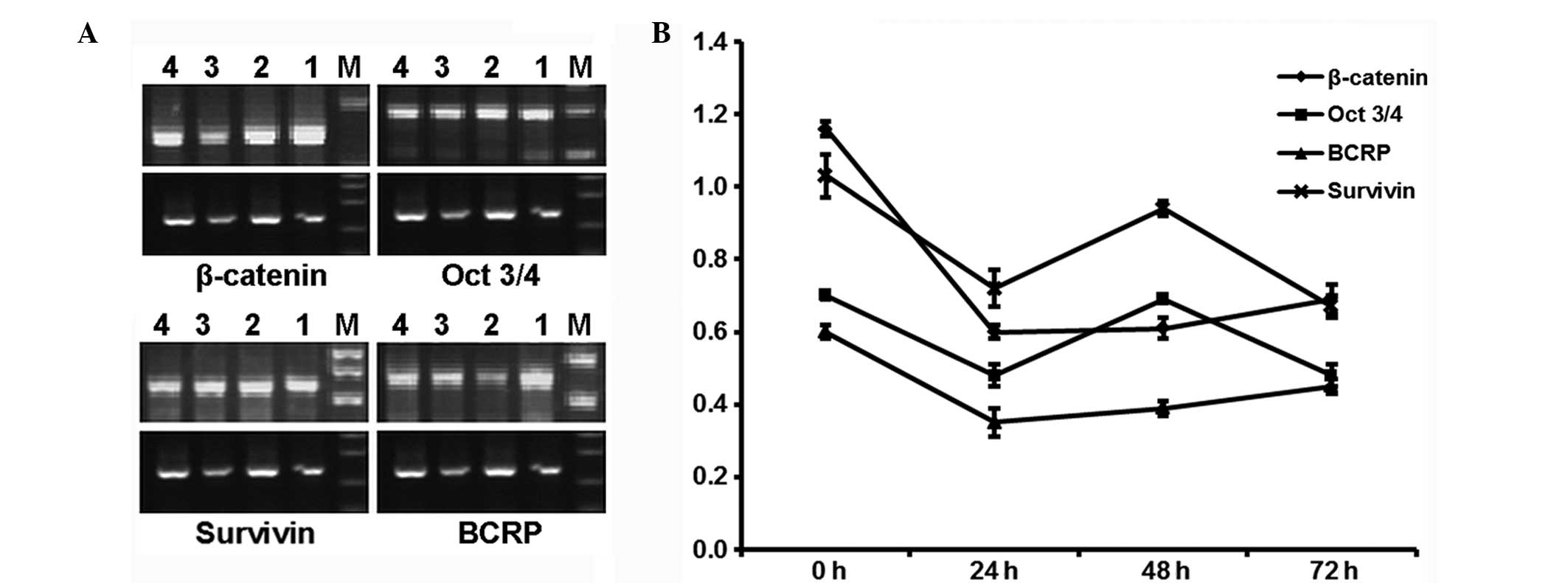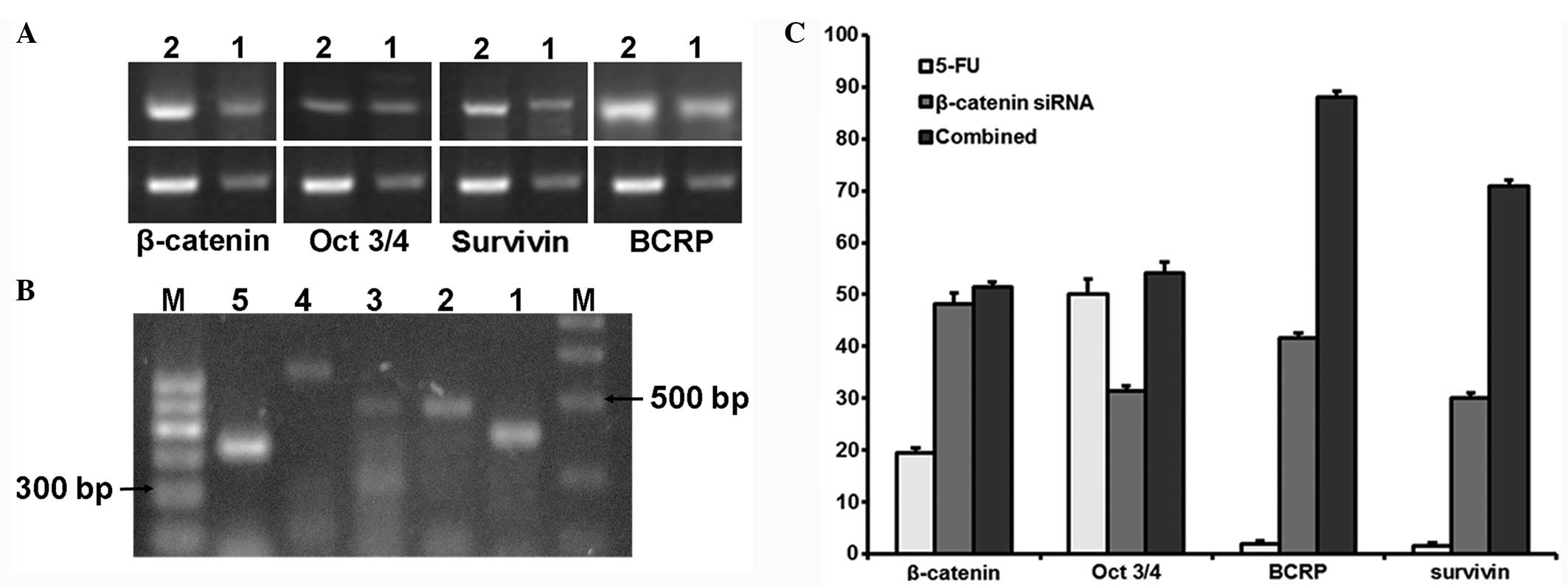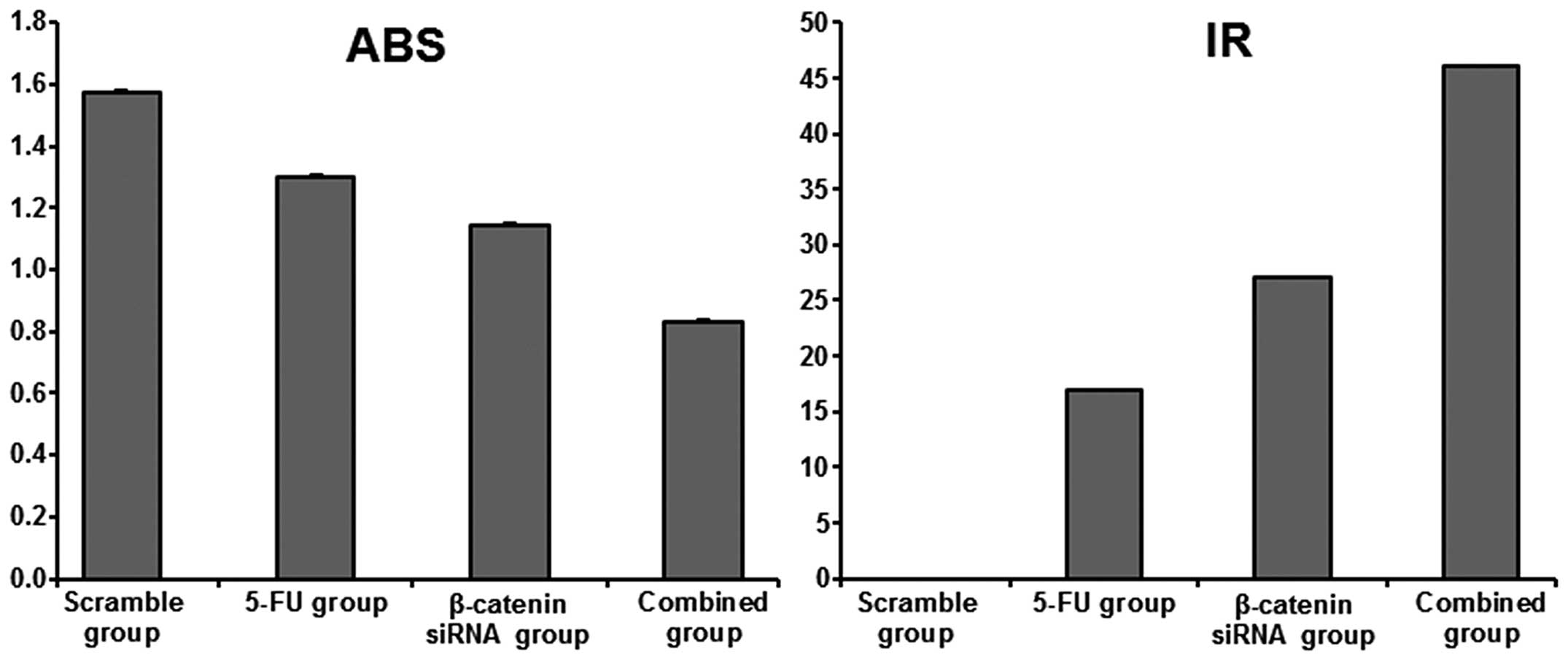β‑catenin knockdown enhances the effects of fluorouracil in the breast cancer cell line MDA‑MB‑468
- Authors:
- Published online on: August 26, 2014 https://doi.org/10.3892/br.2014.353
- Pages: 910-914
Abstract
Introduction
Tumor invasion, metastasis and drug-resistance of cancer cells are considered to play a vital role in cancer-related mortality (1–5). In addition, cancer cell stemness is a new challenge for cancer therapy as conventional chemotherapy is inefficient in killing the stem/progenitor cells. Signaling pathways, including the Hedgehog, Wnt/β-catenin, Notch, epidermal growth factor receptor (EGFR), phosphorylated EGFR and KIT pathways, are involved in this process.
The Wnt/β-catenin signal transduction pathway is a major pathway regulating cancer cell fate. As indicated in certain studies (6–8), the activity of this pathway is necessary for the maintenance of stem cell self-renewal and non-differentiation in normal tissues, and promotes the amplification of stem cells in tumors. β-catenin, as the only component in the third section of the pathway, may be an ideal therapeutic target. However, the role of β-catenin signaling in breast cancer is unclear.
The present study aimed to investigate whether impairing β-catenin expression could decrease proliferation and drug-resistance of tumor stem cells. β-catenin expression in a highly metastatic breast cancer cell line (MDA-MB-468) was repressed using small interfering RNA (siRNA). The subsequent changes in stem/progenitor cells-related factors and in the inhibition rates were monitored using siRNA and chemotherapy, alone or in combination.
Materials and methods
Cell culture
The breast cancer cell line, MDA-MB-468, was obtained from the Chinese-United Kingdom Medical Laboratory (Basic Medical College, Zhengzhou University, Zhengzhou, China). The cells were cultured at 37°C with 5% CO2 in Dulbecco’s modified Eagle’s medium (HyClone, Thermo Fisher Scientific, Inc., Waltham, MA, USA) supplemented with 10% fetal calf serum (Hyclone, Thermo Fisher Scientific, Inc.), 100 U/ml of penicillin G and 100 μg/ml of streptomycin (Gibco-Invitrogen, Carlsbad, CA, USA).
RNA interference
Cell cultures were randomly assigned to the scramble RNA or the siRNA groups. The scramble RNA group was transfected with scramble siRNA and the siRNA group was transfected with β-catenin siRNA. The siRNAs were obtained from Shanghai GenePharma Co., Ltd., (Shanghai, China) and Lipofectamine™ 2000 was obtained from Invitrogen. Interference was performed in 6- and 96-well culture plates, according to the manufacturer’s instructions. Protein and total RNA 24, 48 and 72 h after interference were extracted from 6 plates to perform western blotting and semi-quantitative reverse transcription-polymerase chain reaction (RT-qPCR).
Western blotting
Cells were lyzed in Western and immunoprecipitation cell lysis solution (Beyotime Institute of Biotechnology, Haimen, China). Protein concentrations were determined using the Lowry method (9) in duplicate and the results were averaged. Aliquots of the tissue samples corresponding to 50 μg of total protein were heated at 100°C for 10 min with an equivalent volume of 2X sample buffer (containing 4% SDS and 10% mercaptoethanol) and loaded onto 10% polyacrylamide gels. The proteins were electrotransferred to polyvinylidene difluoride membranes (Bio-Rad, Hercules, CA, USA) in Tris-glycine-methanol buffer. The membranes were blocked for 1 h at room temperature in a blocking solution containing 5% skimmed milk. The membranes were subsequently incubated overnight at 4°C with mouse monoclonal anti-human β-catenin antibodies (Santa Cruz Biotechnology, Inc., Santa Cruz, CA, USA), followed by incubation with horseradish peroxidase-conjugated goat anti-mouse immunoglobulin G. The proteins of interest were visualized using the enhanced DAB western blotting detection reagents and analyzed using the Quantity One software (Bio-Rad).
Semi-RT-qPCR
Total RNA was extracted from cultured cells using TRIzol (Qiagen, Venlo, Netherlands), according to the manufacturer’s instructions. Total RNA (1–5 μg) was reverse-transcribed using the TIANScript RT kit [Tiangen Biotech (Beijing) Co., Ltd., Beijing, China] and the provided oligo(dT)18 primers. The amount of cDNA was normalized to the internal control, β-actin. All the primers and the annealing temperature are listed in Table I. PCR analysis was performed with the Golden Easy PCR system [Tiangen Biotech (Beijing) Co., Ltd.].
Chemotherapy
In the fluorouracil (5-FU) group, the cells were treated with 5-FU alone (1 μg/ml final concentration). In the 5-FU/siRNA group, the cells were treated with β-catenin siRNA and subsequently with 5-FU (1 μg/ml final concentration) 24 h after siRNA.
Cell growth inhibition rate
The cells were inoculated in 96-well culture plates at 5,000 cells/well and treated according to their specific group. The Cell Counting kit-8 (CCK-8) solution (Beyotime Institute of Biotechnology) was added at 24, 48 and 72 h in the siRNA group and at 24 h in the 5-FU and 5-FU/siRNA groups, prior to incubation for 2 h. Following incubation, the absorbance (ABS) of each sample was measured at 450 nm. Inhibition Rate (IR) = (ABS of experimental group - ABS of scramble group)/ABS of scramble group × 100%.
Statistical analysis
All the experiments were repeated five times and the mean values were used for statistical analyses. Statistical analysis was performed using SPSS 13.0 (SPSS, Inc., Chicago, IL, USA). Comparisons between the groups at each time interval were performed using one-way analysis of variance. The associations between the factors were determined by two-sided Pearson correlation analysis. P<0.05 was considered to indicate a statistically significant difference.
Results
Effect of β-catenin interference on mRNA expression of β-catenin, Oct3/4, survivin and BCRP
β-catenin, Oct3/4, survivin and BCRP mRNA expression was decreased at 24, 48 and 72 h after interference in the siRNA group and the inhibition rate at 24 h was the most evident (48%). The curves for each mRNA were consistent (Fig. 1).
mRNA expression of β-catenin, Oct3/4, survivin and BCRP under chemotherapy
The above data showed that β-catenin interference was the most efficient at 24 h. Therefore, 24 h after β-catenin siRNA transfection, 5-FU (1 μg/ml) or saline was added to the MDA-MB-468 cells. RT-qPCR results showed that 5-FU inhibited the mRNA expression of β-catenin, Oct3/4, survivin and BCRP. Furthermore, β-catenin siRNA transfection enhanced the inhibition rate of 5-FU on these genes (Fig. 2). These results indicated that β-catenin siRNA enhanced the inhibition of Oct3/4, survivin and BCRP gene expression by 5-FU.
Cell growth inhibition rates
CCK-8 analyses were used to assess the cell growth inhibition rate under different conditions. In the 5-FU or siRNA groups, the cell growth inhibition rates were 17 and 27%, respectively. In the 5-FU/siRNA group, the cell growth inhibition rate was 46%, which was significantly different compared to the other two groups (P<0.05). These results indicated that β-catenin siRNA could enhance the inhibition rate of 5-FU chemotherapy on cell growth (Fig. 3).
Discussion
Distant metastases and invasion are responsible for >90% of cancer-related mortalities (10). The initial stage of metastatic progression is essentially dependent upon important biological events, including cell proliferation, epithelial-mesenchymal transition, drug resistance and cancer cell stemness (11,12).
Wnt/β-catenin signaling has been demonstrated to play an important role in metastasis development (13). In the study by DiMeo et al (14), the downstream target genes of the Wnt/β-catenin pathway were found to be significantly upregulated in early breast cancer metastatic cells in the lungs of a mouse model. Another study revealed that β-catenin is upregulated in human cancers and correlates with poor prognosis (15). The accumulation of nuclear β-catenin in the invasive fronts of primary tumors further emphasizes the critical role of β-catenin in the metastatic process (16). Previous studies have suggested that the β-catenin pathway may play a pivotal role in cancer metastasis and invasion (14–16). In the present study, it was shown that the β-catenin pathway affects the expression of genes involved in cell proliferation, drug resistance and cell stemness.
Following β-catenin siRNA transfection, β-catenin mRNA expression showed a significant downregulation compared to the scramble siRNA group, demonstrating the validity of the transfection. In the present study, mRNA expression of the stem/progenitor marker Oct3/4 decreased when β-catenin was repressed, indicating that decreasing β-catenin may be an effective way for reducing the proportion of stem/progenitor cells. Simultaneously, the mRNA expression of the anti-apoptosis factor survivin and the drug-resistance factor BCRP decreased similarly, showing a positive association between β-catenin, Oct3/4, survivin and BCRP expression. These results showed that stem/progenitor cells had inherent anti-apoptosis and drug-resistant properties, consistent with previous studies (5,17,18).
Oct3/4 encodes a transcription factor involved in embryonic development, ensuring embryonic stem cell pluripotency (19) and participating in stem cell renewal (20). Oct3/4 is a stem/progenitor cell general marker and represents the existence or quantity/functional changes in stem/progenitor cells. BCRP is a member of the adenosine triphosphate-binding cassette transporters superfamily involved in multi-drug resistance of cancer stem cells (21–23). Survivin encodes a negative regulatory protein that prevents apoptotic cell death (17) and is associated with drug-resistance of stem cells (5,18).
In the present study, Oct3/4, survivin and BCRP expression were significantly inhibited in the MDA-MB-468 cell line due to the knockdown of β-catenin. Oct3/4, survivin and BCRP expression were associated with breast cancer cell stemness, proliferation and drug resistance. However, there was no detailed data that showed that β-catenin knockdown could affect MDA-MB-468 cell stemness and drug resistance. However, cell proliferation was inhibited significantly following β-catenin knockdown. These results demonstrated that β-catenin could be a potential candidate for breast cancer therapy.
There are limited studies on the effects of decreasing β-catenin expression to restrain cancer stem/progenitor cells. Wang et al (24) silenced the expression of β-catenin in the esophageal cancer cell line, Eca-109, using little hairpin RNA and found that the cell cycle was blocked in the G0/G1 stage, resulting from the decreased expression of cyclin D1. A decrease in cell growth and colony formation rates were also observed, which could be used as a surrogate for stem cells quantity. These results are consistent with the aforementioned previous studies.
The present study revealed that the β-catenin inhibition rate (for mRNA and protein) was higher 24 h after transfection. The inhibition rate in the siRNA/5-FU and 5-FU groups was more evident compared to the siRNA group, possibly due to the decreased capacity of anti-apoptosis and drug-resistance resulting from decreased β-catenin protein expression. The data of the present study indicated that combining 5-FU with gene silencing could be an advantageous option for enhancing the curative effect of chemotherapy in breast cancer and other malignancies.
In conclusion, these preliminary results indicate that knockdown of β-catenin enhanced 5-FU-induced proliferation inhibition of the breast cancer cell line MDA-MB-468.
Acknowledgements
The present study was supported by a grant from the National Natural Science Foundation of China (grant no. 81172179).
References
|
Eramo A, Ricci-Vitiani L, Zeuner A, et al: Chemotherapy resistance of glioblastoma stem cells. Cell Death Differ. 13:1238–1241. 2006. View Article : Google Scholar : PubMed/NCBI | |
|
Dean M: ABC transporters, drug resistance, and cancer stem cells. J Mammary Gland Biol Neoplasia. 14:3–9. 2009. View Article : Google Scholar : PubMed/NCBI | |
|
Dean M, Fojo T and Bates S: Tumour stem cells and drug resistance. Nat Rev Cancer. 5:275–284. 2005. View Article : Google Scholar | |
|
Phillips TM, McBride WH and Pajonk F: The response of CD24(−/low)/CD44+ breast cancer-initiating cells to radiation. J Natl Cancer Inst. 98:1777–1785. 2006. | |
|
Tanei T, Morimoto K, Shimazu K, et al: Association of breast cancer stem cells identified by aldehyde dehydrogenase 1 expression with resistance to sequential Paclitaxel and epirubicin-based chemotherapy for breast cancers. Clin Cancer Res. 15:4234–4241. 2009. View Article : Google Scholar : PubMed/NCBI | |
|
Reya T and Clevers H: Wnt signalling in stem cells and cancer. Nature. 434:843–850. 2005. View Article : Google Scholar : PubMed/NCBI | |
|
Li Y, Welm B, Podsypanina K, et al: Evidence that transgenes encoding components of the Wnt signaling pathway preferentially induce mammary cancers from progenitor cells. Proc Natl Acad Sci USA. 100:15853–15858. 2003. View Article : Google Scholar : PubMed/NCBI | |
|
Liu BY, McDermott SP, Khwaja SS and Alexander CM: The transforming activity of Wnt effectors correlates with their ability to induce the accumulation of mammary progenitor cells. Proc Natl Acad Sci USA. 101:4158–4163. 2004. View Article : Google Scholar : PubMed/NCBI | |
|
Lowry OH, Rosebrough NJ, Farr AL and Randall RJ: Protein measurement with the Folin phenol reagent. J Biol Chem. 193:265–275. 1951.PubMed/NCBI | |
|
Chaffer CL and Weinberg RA: A perspective on cancer cell metastasis. Science. 331:1559–1564. 2011. View Article : Google Scholar : PubMed/NCBI | |
|
Steeg PS: Tumor metastasis: mechanistic insights and clinical challenges. Nat Med. 12:895–904. 2006. View Article : Google Scholar : PubMed/NCBI | |
|
Thiery JP, Acloque H, Huang RY and Nieto MA: Epithelial-mesenchymal transitions in development and disease. Cell. 139:871–890. 2009. View Article : Google Scholar : PubMed/NCBI | |
|
Fu Y, Zheng S, An N, et al: β-catenin as a potential key target for tumor suppression. Int J Cancer. 129:1541–1551. 2011. | |
|
DiMeo TA, Anderson K, Phadke P, et al: A novel lung metastasis signature links Wnt signaling with cancer cell self-renewal and epithelial-mesenchymal transition in basal-like breast cancer. Cancer Res. 69:5364–5373. 2009. View Article : Google Scholar : PubMed/NCBI | |
|
Lin SY, Xia W, Wang JC, et al: Beta-catenin, a novel prognostic marker for breast cancer: its roles in cyclin D1 expression and cancer progression. Proc Natl Acad Sci USA. 97:4262–4266. 2000. View Article : Google Scholar : PubMed/NCBI | |
|
Brabletz T, Jung A, Reu S, et al: Variable beta-catenin expression in colorectal cancers indicates tumor progression driven by the tumor environment. Proc Natl Acad Sci USA. 98:10356–10361. 2001. View Article : Google Scholar : PubMed/NCBI | |
|
Khan S, Aspe JR, Asumen MG, et al: Extracellular, cell-permeable survivin inhibits apoptosis while promoting proliferative and metastatic potential. Br J Cancer. 100:1073–1086. 2009. View Article : Google Scholar : PubMed/NCBI | |
|
Woodward WA, Chen MS, Behbod F, Alfaro MP, Buchholz TA and Rosen JM: WNT/beta-catenin mediates radiation resistance of mouse mammary progenitor cells. Proc Natl Acad Sci USA. 104:618–623. 2007. View Article : Google Scholar : PubMed/NCBI | |
|
Schöler HR, Dressler GR, Balling R, Rohdewohld H and Gruss P: Oct-4: a germline-specific transcription factor mapping to the mouse t-complex. EMBO J. 9:2185–2195. 1990.PubMed/NCBI | |
|
Schöler HR, Ruppert S, Suzuki N, Chowdhury K and Gruss P: New type of POU domain in germ line-specific protein Oct-4. Nature. 344:435–439. 1990.PubMed/NCBI | |
|
Nakanishi T, Chumsri S, Khakpour N, et al: Side-population cells in luminal-type breast cancer have tumour-initiating cell properties, and are regulated by HER2 expression and signalling. Br J Cancer. 102:815–826. 2010. View Article : Google Scholar : PubMed/NCBI | |
|
Nguyen NP, Almeida FS, Chi A, et al: Molecular biology of breast cancer stem cells: potential clinical applications. Cancer Treat Rev. 36:485–491. 2010. View Article : Google Scholar : PubMed/NCBI | |
|
Abaan OD, Mutlu PK, Baran Y, Atalay C and Gunduz U: Multidrug resistance mediated by MRP1 gene overexpression in breast cancer patients. Cancer Invest. 27:201–205. 2009. View Article : Google Scholar : PubMed/NCBI | |
|
Wang JS, Zheng CL, Wang YJ, et al: Gene silencing of beta-catenin by RNAi inhibits cell proliferation in human esophageal cancer cells in vitro and in nude mice. Dis Esophagus. 22:151–162. 2009. View Article : Google Scholar : PubMed/NCBI |












